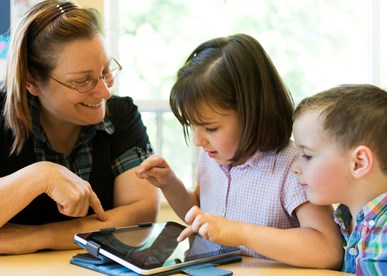The relationships that children have with peers, adults and other people have a strong influence on how they use Information and Communication Technologies (ICT) or what is known as digital technologies in their lives. As technology continues to permeate our lives in a profound manner the extent to which young children will learn from the people in their lives will also significantly impact their perspectives and use of ICT in society.
Throughout the Early Years Learning Framework early childhood teachers and carers are encouraged are to work towards responsive relationships in early childhood education. This is recognised in each of the key themes in the EYLF – Belonging, Being, and Becoming – and re-emphasised again in the Statement on Young Children and Digital Technologies (Early Childhood Australia, 2019).
Within any early learning environment, relationships can be forged between child and child, child and early childhood educators, or parents and early childhood educators. Any developmentally appropriate practice should, therefore, always include a focus on the role of relationships in early learning and the important role of social interactions.
The many roles that ICT has can enhance relationships in early childhood education and care whether it is between children and adults, child and child, or parent and early childhood teachers (Office of Educational Technology):
“Technology can also be used to enhance relationships between children and adults and between children when distance or other barriers such as health prevent in-person interaction.”
Early Childhood Pedagogy
Pedagogical practices in early childhood education involve that of nurturing and building relationships. It represents the holistic nature of professional practice and strengthens the curriculum decision-making and the teaching and learning approach undertaken. Therefore, respectful relationships in early childhood education underpin the key principles involved in early childhood pedagogy.
As technology continues to have a profound impact on young children’s lives and the relationships that they are in with other people continue to influence the way they use and perceive technology pedagogical practices in early childhood education must break the habit of ‘taking it for granted’.
There is clear evidence relating to high quality pedagogical practices in early childhood education services. For example, “the relationship between child and caregiver has a critical impact on the developing structure of the child’s brain that influences his/her capacities and capabilities in adult life. Early experiences activate genetic expression resulting in the formation of critical neural pathways within the brain” (Child Australia, 2021, p. 6).
This evidence from neuroscience stresses the need for positive relationships in early childhood education.
Early childhood pedagogy that involves technology use, therefore, depends on your ability to nurture and respect relationships between child and child, child and early childhood teacher, and also parent/carer and early childhood teacher.
Relationships are a critical aspect of technological pedagogical practices in early childhood education.
Child Learning
Throughout the Early Years Learning Framework the role that relationships in early childhood education play is considerable. Children’s play is dynamic, holistic and complex and assists children to develop relationships and concepts. It will be your teaching strategies and the relationships that you form with children and their families that ensure will have a significant effect on their involvement and success in ICT learning.
Children can learn with digital technology in early childhood education in the following ways:
- Sharing positive experiences by co-viewing digital media and supporting child-adult relationships;
- Sharing how they have learned to use a particular digital technology with their peers and actively teaching each other functions of the digital technology;
- Collaboratively working in teams together on digital technology as a result of early childhood teachers creating opportunities for this to occur.
It is a priority for you as an early childhood teacher to nurture relationships and provide them with consistent emotional support so that you can assist children in the development of ICT techniques and skills in ICT capability.

Creativity and Collaboration
By doing this, two other important aspects of the EYLF are achieved. That is to value collaboration and teamwork – both significant to the effective use of technology in early childhood education. To maximise the learning potential of ICTs in early childhood creativity, communication and collaboration must be emphasised.
As the second guiding principle in DATEC, the use of digital technology at your early childhood education and care centre states that you should encourage collaboration with technology and ask key questions such as:
- How is the technology provided?
- Are areas around a tape recorder, CD-player or computer inviting for adults and children to sit together?
- Are children able to combine materials effectively together: for example, to add Bee Bots to play with blocks so that they have a context for shared imagination and problem solving?
(Harriet, 2009, p2)
In relation to creativity, it is essential that you encourage, nurture, and extend children’s creativity through your relationships and interactions with them. This can best be achieved if you provide them with a wide range of open-ended and meaningful ICT experiences with plenty of opportunities to explore and interact with others.
Buidling Relationships in early childhood education and care can be fostered and built upon when you share and document children’s learning with themselves, families and each other. The use of digital technology can help achieve this and some key examples include:
- Computer software such as PowerPoint to share the learning journey children take;
- Projectors along with IWB and screens can share displays with large groups of children, parents and adults;
- Digital cameras and recorders such as webcams, stand-alone cameras and that exists on tablet computers and smartphones.
